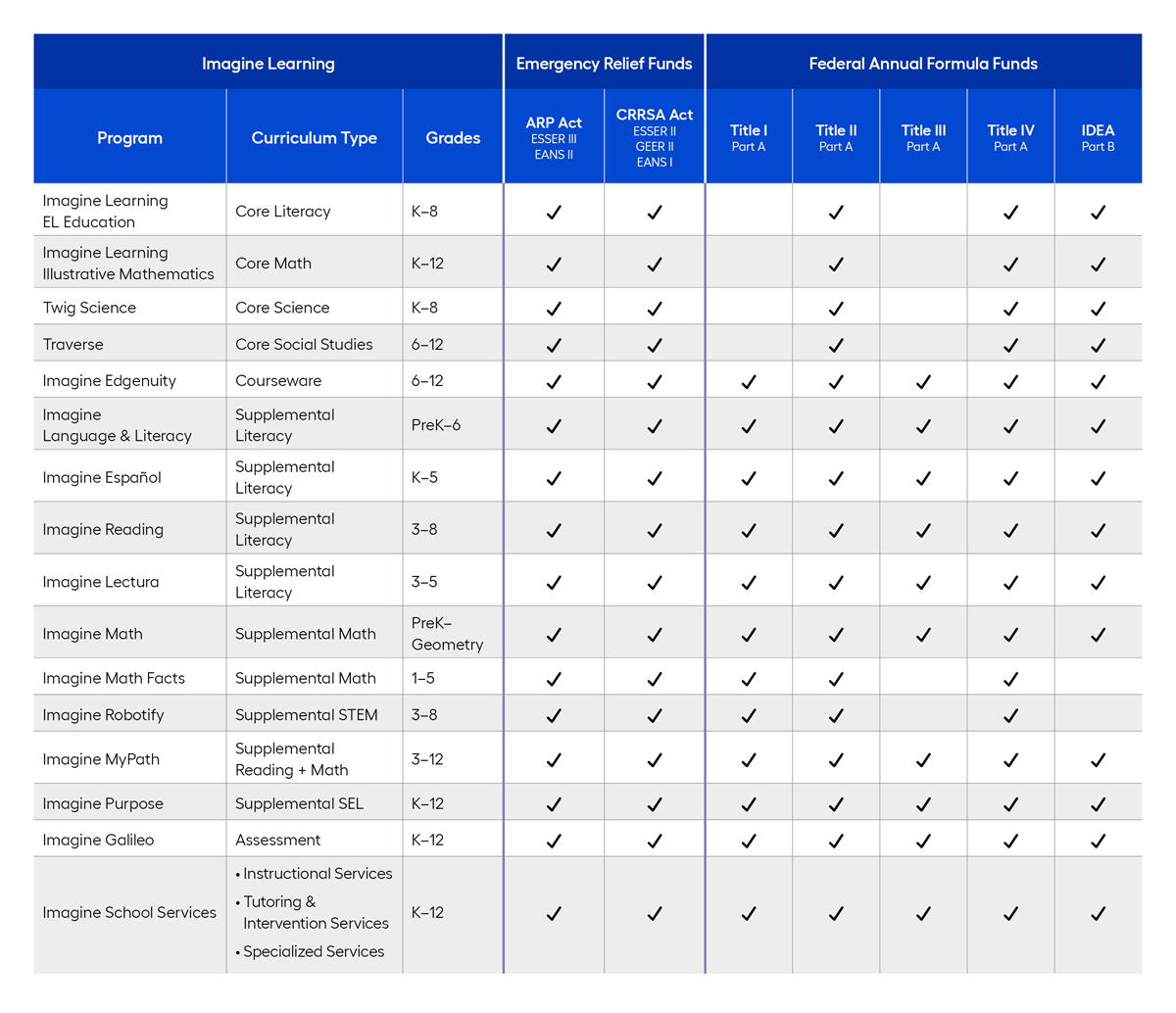Funding & Resources
Learn how Imagine Learning’s qualified programs meet your funding requirements and create equitable pathways for each student.
Imagine More Equitable Learning Opportunities
Education budgets are complex, and matching funding with programs to solve inequities in your community isn’t always easy. We’re here to help.

Find the help you need, including:
- Federal funding overview
- Funding STEM learning breakthroughs
- Spending the remaining ESSER III funds
- Private sector grant opportunities
Federal Funding Overview
The federal government provides funding to schools through its primary agency, the U.S. Department of Education. Federal funding for education can be broken down into three buckets: formula, discretionary, and emergency funds. The largest amounts of money traditionally come through Title I under ESSA (Every Student Succeeds Act), and IDEA (Individuals with Disabilities Education Act).
The federal government contributes about 8–10% of U.S. public school budgets; the rest of school funding comes from state and local funds such as tax revenues. Federal funds are given to SEAs (State Education Agencies) who sub-grant funds to LEAs (Local Education Agencies).
► IL National Funding Summary Guide (FY24)
► IL National Funding Summary Guide (FY25) – Coming Soon

Main sources of federal education programs
Every Student Succeeds Act (ESSA)
Supplements state and local resources and supports students from low-income families and low-achieving schools.
Individuals with Disabilities Education Act (IDEA)
IDEA governs how states and public agencies provide early intervention, special education, and related services to more than 7.2 million eligible students and adults (ages 3–21 years old) served under IDEA, Part B.
Federal PreK–12 education grants
Grant Type: Formula
Uses formulas determined by Congress to allocate funds to SEAs and LEAs.
Examples of Funds:
- Title I, Part A “Improving the Academic Achievement of the Disadvantaged”
- Title I, Part C “Migrant Education Programs”
- Title II, Part A “Supporting Effective Instruction State Grants”
- Title III, Part A “English Language Acquisition”
- Title IV, Part A “Student Support and Academic Enrichment Grants”
- IDEA, Part B “Grants to States”
Grant Type: Discretionary
Awarded using a competitive grant application process.
Examples of Funds:
- Title IV, Part B “21st Century Community Learning Centers”
- Title IV, Part E “Statewide Family Engagement Centers Program”
- Striving Readers “Comprehensive Literacy State Development”
- Innovative Approaches to Literacy
Funding STEM learning Breakthroughs
Funding for STEM programming in the United States is extensive across federal, state, and local government entities, private individuals and institutions, and non-profit organizations. Accurate levels for every source are difficult to determine, but broadly, the primary funding sources are:
COVID-19 EMERGENCY RELIEF FUNDS
State and Local Education Agencies (SEAs, LEAs) may use emergency relief funds toward STEM programming.
ANNUAL FEDERAL FORMULA FUNDS
Leverage the Every Student Succeeds Act (ESSA) formula programs for supplementary STEM education.
STATE AND LOCAL FUNDS
Programs vary by state and local jurisdiction.
PRIVATE INSTITUTIONS
Corporations, foundations, individuals, and other private organizations provide grant opportunities for STEM education.
COMPETITIVE GRANTS
Government entities award STEM grants to eligible education organizations through competitive grant applications.
STATE AND LOCAL FUNDS
Programs vary by state and local jurisdiction.
Discover our PreK–12 STEM Funding Guide to learn more
Top Five Trends for ARP ESSER III Funds
#1 Accelerating Learning
Students returned from pandemic learning an average of 4 months behind in reading and 5 months behind in math. Educators’ number one priority is helping students recover learning and move towards grade-level achievement.
#2 Social and emotional learning
Educators are widely concerned about the mental, social, emotional, and physical well-being of students, teachers, and families. Addressing the entire community with empathy and humanity is critical both to student and teacher wellness, as well as academic success.
#3 Family, student, and community engagement
Hybrid learning highlighted how essential the school-home connection is to student success. Prioritizing community and family engagement should remain a top priority to support ongoing student achievement and stronger school-family collaborations.
#4 Connectivity and broadband
The pandemic highlighted and exacerbated inequities in access to technology and connectivity across the United States. ARP ESSER III funds are being used towards purchasing educational technology (including hardware, software, and connectivity).
#5 Educator retention and addressing teacher shortages
Difficulties teaching during the pandemic and general burnout has made it difficult for districts to keep quality educators on staff. Retaining educators has, therefore, emerged as a new spending priority.
What priorities does your state have for using ARP ESSER III funding?
Watch our guide to state funding guidelines with Senior Grants Director Dana Pawinski.
Imagine Learning’s Qualified Programs
Our evidence-based solutions qualify for many key PreK–12 federal funding programs:

Private Sector Grant Opportunities

Education philanthropy continues to rise.
COVID-19 dramatically changed the way funders, specifically from the private sector, have traditionally invested in education. Foundations and corporations alike understand the critical importance they have in supporting the social, equitable, and educational needs of schools and districts across the country.
Imagine More Equitable Learning
Find out more about how our evidence-based programs meet your federal, state, and emergency relief funding requirements.
